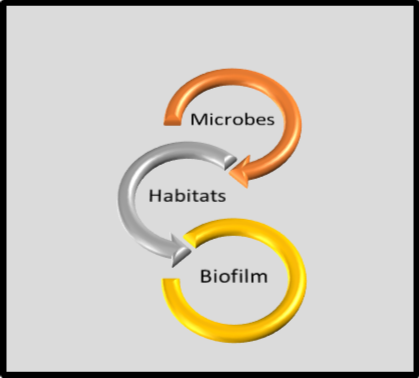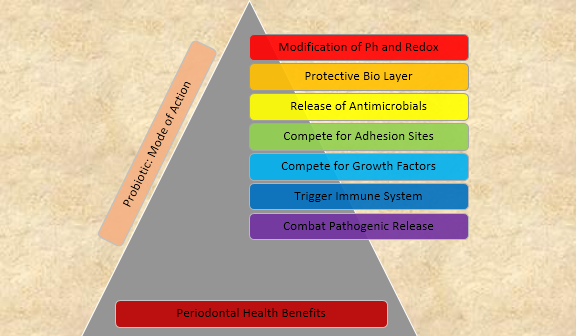Editorial
Volume 1 Issue 1 - 2016
Oral Probiotics: A key for Periodontal Health
Department of Periodontology & Oral Implantology, Pravara Institute of Medical Sciences-Loni, Maharashtra, India
*Corresponding Author: Rajiv Saini, Department of Periodontology & Oral Implantology, Pravara Institute of Medical Sciences-Loni, Maharashtra, India.
Received: June 22, 2016; Published: October 05, 2016
The microorganisms found in the human oral cavity have been referred to as the oral microflora, oral microbiota, or more recently as the oral microbiome. [1] Oral cavity is an exposed progression establishment with a continuous introduction and confiscation of microbes and their habitats. It offers varied environments where-in diverse classes of micro-organisms can flourish leading to biofilm formation as illustrated in figure 1. Periodontitis is inflammation of the tissues surrounding the tooth affecting the gingiva, periodontal ligaments and the bone and in its severe forms there can be loss of bone that supports the tooth, resulting in the tooth becoming loose and even causing tooth loss. The loss of supporting structures can result in the formation of periodontal pocket between the gum and the tooth. Gingivitis is the initial stage of disease progression and can further extend to periodontitis if the bacterial bio burden is not eradicated by the optimal means. [2]
The understanding of dental plaque and its principal microorganisms have shifted from specific plaque hypothesis to a non-specific plaque hypothesis and back again to a theory of specific periodontal pathogens in plaque. Recently dental researchers have begun to view plaque as a biofilm. The nature of a biofilm helps explain why periodontal diseases have been so difficult to prevent and treat. Current methodology and research is now focused on intervention at plaque maturation only so that biofilm establishment can be suppressed, one of the promising future is introduction of Priobiotics to oral cavity.
The World Health Organization and the Food and Agriculture Organization of the United Nations have defined probiotics as “live microorganisms, which, when administered in adequate amounts, confer a health benefit on the host.” They are also called “friendly bacteria” or “good bacteria.” The concept of probiotics arose at the turn of the 20th century from a hypothesis first proposed by the Noble Prize-winning Russian scientist, Elie Metchnikoff. [3] The widespread emergence of bacterial resistance to antibiotics has also led to the concept of probiotic therapy for application in oral health. Dental caries, periodontal disease and halitosis are among the oral disorders that have been targeted. An essential condition for a microorganism to represent a probiotic of interest for oral health is its capacity to adhere to and colonize various surfaces of the oral cavity. Probiotic can play a significant role in promoting periodontal health as illustrated in figure 2.
Few products containing probiotics (such as tablets, lozenges, chewing gums or tooth pastes) are currently available in market; however Pro-Dental from Hyperbiotics (USA) is premium dental probiotic supplement specifically designed for attaining complete oral and periodontal health. The key ingredients include Streptococcus salivarius K12, Streptococcus salivarius M18, Lactobacillus Reuteri, Lactobacillus Reuteri and Chelated Zinc that not only prevent pathogenic proliferation but also act as oral health immune booster. Another unique of feature of Hyperbiotics is sustaining viability of live cells for longer duration because of its patented method from Nutraceutix, called LiveBac®.
The mouth acts as a window to lot of systemic diseases and serves as a port of entry of the various infections that can alter and affect the immune status of the person. The oral cavity has the potential to harbor at least 600 different bacterial species, and in any given patient, more than 150 species may be present, surfaces of teeth can have as much as billion bacteria in its attached bacterial plaque. [4] Periodontitis has been proposed as having an etiological or modulating role in cardiovascular, cerebrovascular disease, diabetes, respiratory disease and adverse pregnancy outcome; several mechanisms have been proposed to explain or support such theories. Dental plaque biofilm cannot be eliminated. However, the pathogenic nature of the dental plaque biofilm can be reduced by reducing the bioburden (total microbial load and different pathogenic isolates within that dental plaque biofilm) and maintaining a normal flora with appropriate oral hygiene methods. [5] Probiotic inclusion in oral hygiene represents a breakthrough approach to maintain oral health by utilizing the natural beneficial bacteria commonly found in healthy mouth to provide natural defense against those bacteria thought to be harmful to teeth and gums.
References
- Lederberg JA and Mccray T. “Ome sweet omics: a genealogical treasury of words". Scientist 15.7 (2001): 8-10.
- Saini R. “A Prospective ExperimentalComparative Study on the Clinical Effects of CalculusDissolution based Oral Rinse in Gingivitis Patients”. International Journal of Experimental Dental Science 4.1 (2015): 33-39.
- Saini R., et al. “Potential of probiotics in controlling cardiovascular diseases". Journal of Cardiovascular Disease Research 1.4 (2010): 213-214.
- Saini R., et al. “Oral sex, oral health and orogenital infections”. Journal of Global Infectious Diseases 2.1 (2010): 57-62.
- Saini R., et al. “Biofilm: A dental microbial infection”. Journal of Natural Science, Biology and Medicine 2.1 (2011): 71-75.
Citation:
Rajiv Saini. “Oral Probiotics: A key for Periodontal Health”. Oral Health and Dentistry 1.1 (2016): 8-9.
Copyright: © 2016 Rajiv Saini. This is an open-access article distributed under the terms of the Creative Commons Attribution License, which permits unrestricted use, distribution, and reproduction in any medium, provided the original author and source are credited.





































 Scientia Ricerca is licensed and content of this site is available under a Creative Commons Attribution 4.0 International License.
Scientia Ricerca is licensed and content of this site is available under a Creative Commons Attribution 4.0 International License.